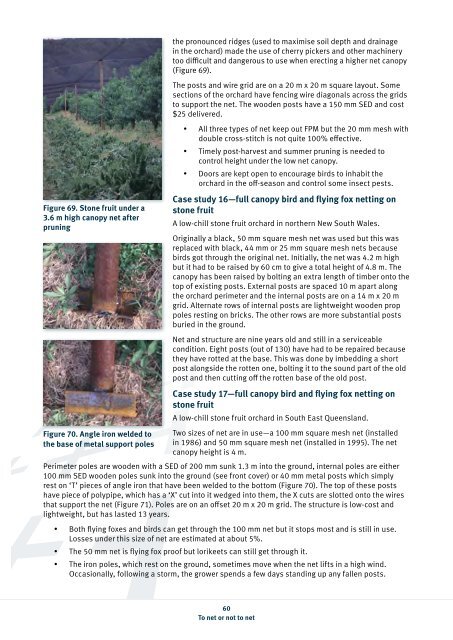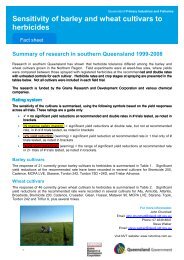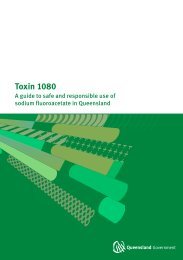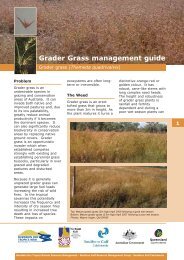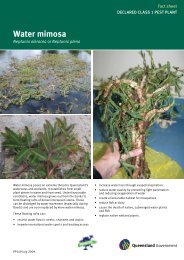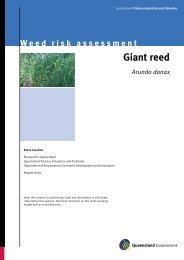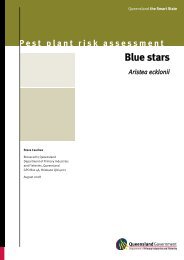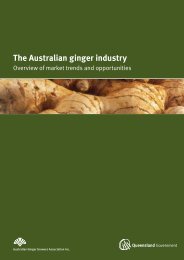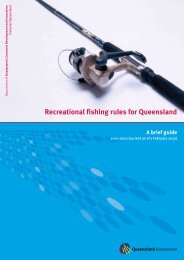To net or not to net - 3rd edition - Department of Primary Industries
To net or not to net - 3rd edition - Department of Primary Industries
To net or not to net - 3rd edition - Department of Primary Industries
You also want an ePaper? Increase the reach of your titles
YUMPU automatically turns print PDFs into web optimized ePapers that Google loves.
Figure 69. S<strong>to</strong>ne fruit under a<br />
3.6 m high canopy <strong>net</strong> after<br />
pruning<br />
Figure 70. Angle iron welded <strong>to</strong><br />
the base <strong>of</strong> metal supp<strong>or</strong>t poles<br />
the pronounced ridges (used <strong>to</strong> maximise soil depth and drainage<br />
in the <strong>or</strong>chard) made the use <strong>of</strong> cherry pickers and other machinery<br />
<strong>to</strong>o difficult and dangerous <strong>to</strong> use when erecting a higher <strong>net</strong> canopy<br />
(Figure 69).<br />
The posts and wire grid are on a 20 m x 20 m square layout. Some<br />
sections <strong>of</strong> the <strong>or</strong>chard have fencing wire diagonals across the grids<br />
<strong>to</strong> supp<strong>or</strong>t the <strong>net</strong>. The wooden posts have a 150 mm SED and cost<br />
$25 delivered.<br />
•<br />
•<br />
•<br />
All three types <strong>of</strong> <strong>net</strong> keep out FPM but the 20 mm mesh with<br />
double cross-stitch is <strong>not</strong> quite 100% effective.<br />
Timely post-harvest and summer pruning is needed <strong>to</strong><br />
control height under the low <strong>net</strong> canopy.<br />
Do<strong>or</strong>s are kept open <strong>to</strong> encourage birds <strong>to</strong> inhabit the<br />
<strong>or</strong>chard in the <strong>of</strong>f-season and control some insect pests.<br />
Case study 16—full canopy bird and flying fox <strong>net</strong>ting on<br />
s<strong>to</strong>ne fruit<br />
A low-chill s<strong>to</strong>ne fruit <strong>or</strong>chard in n<strong>or</strong>thern New South Wales.<br />
Originally a black, 50 mm square mesh <strong>net</strong> was used but this was<br />
replaced with black, 44 mm <strong>or</strong> 25 mm square mesh <strong>net</strong>s because<br />
birds got through the <strong>or</strong>iginal <strong>net</strong>. Initially, the <strong>net</strong> was 4.2 m high<br />
but it had <strong>to</strong> be raised by 60 cm <strong>to</strong> give a <strong>to</strong>tal height <strong>of</strong> 4.8 m. The<br />
canopy has been raised by bolting an extra length <strong>of</strong> timber on<strong>to</strong> the<br />
<strong>to</strong>p <strong>of</strong> existing posts. External posts are spaced 10 m apart along<br />
the <strong>or</strong>chard perimeter and the internal posts are on a 14 m x 20 m<br />
grid. Alternate rows <strong>of</strong> internal posts are lightweight wooden prop<br />
poles resting on bricks. The other rows are m<strong>or</strong>e substantial posts<br />
buried in the ground.<br />
Net and structure are nine years old and still in a serviceable<br />
condition. Eight posts (out <strong>of</strong> 130) have had <strong>to</strong> be repaired because<br />
they have rotted at the base. This was done by imbedding a sh<strong>or</strong>t<br />
post alongside the rotten one, bolting it <strong>to</strong> the sound part <strong>of</strong> the old<br />
post and then cutting <strong>of</strong>f the rotten base <strong>of</strong> the old post.<br />
Case study 17—full canopy bird and flying fox <strong>net</strong>ting on<br />
s<strong>to</strong>ne fruit<br />
A low-chill s<strong>to</strong>ne fruit <strong>or</strong>chard in South East Queensland.<br />
Two sizes <strong>of</strong> <strong>net</strong> are in use—a 100 mm square mesh <strong>net</strong> (installed<br />
in 1986) and 50 mm square mesh <strong>net</strong> (installed in 1995). The <strong>net</strong><br />
canopy height is 4 m.<br />
Perimeter poles are wooden with a SED <strong>of</strong> 200 mm sunk 1.3 m in<strong>to</strong> the ground, internal poles are either<br />
100 mm SED wooden poles sunk in<strong>to</strong> the ground (see front cover) <strong>or</strong> 40 mm metal posts which simply<br />
rest on ‘T’ pieces <strong>of</strong> angle iron that have been welded <strong>to</strong> the bot<strong>to</strong>m (Figure 70). The <strong>to</strong>p <strong>of</strong> these posts<br />
have piece <strong>of</strong> polypipe, which has a ‘X’ cut in<strong>to</strong> it wedged in<strong>to</strong> them, the X cuts are slotted on<strong>to</strong> the wires<br />
that supp<strong>or</strong>t the <strong>net</strong> (Figure 71). Poles are on an <strong>of</strong>fset 20 m x 20 m grid. The structure is low-cost and<br />
lightweight, but has lasted 13 years.<br />
• Both flying foxes and birds can get through the 100 mm <strong>net</strong> but it s<strong>to</strong>ps most and is still in use.<br />
Losses under this size <strong>of</strong> <strong>net</strong> are estimated at about 5%.<br />
•<br />
•<br />
The 50 mm <strong>net</strong> is flying fox pro<strong>of</strong> but l<strong>or</strong>ikeets can still get through it.<br />
The iron poles, which rest on the ground, sometimes move when the <strong>net</strong> lifts in a high wind.<br />
Occasionally, following a st<strong>or</strong>m, the grower spends a few days standing up any fallen posts.<br />
60<br />
<strong>To</strong> <strong>net</strong> <strong>or</strong> <strong>not</strong> <strong>to</strong> <strong>net</strong>


